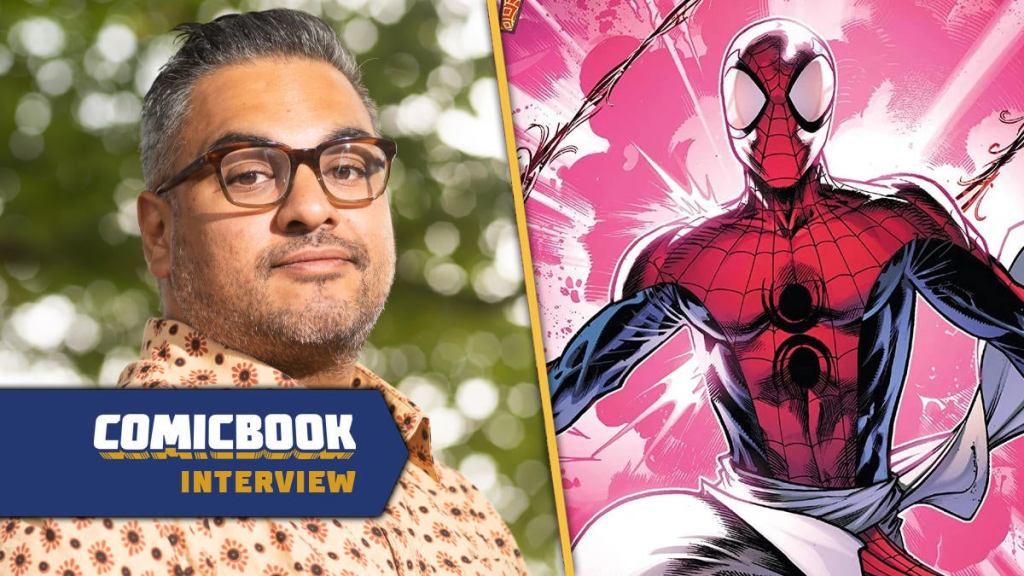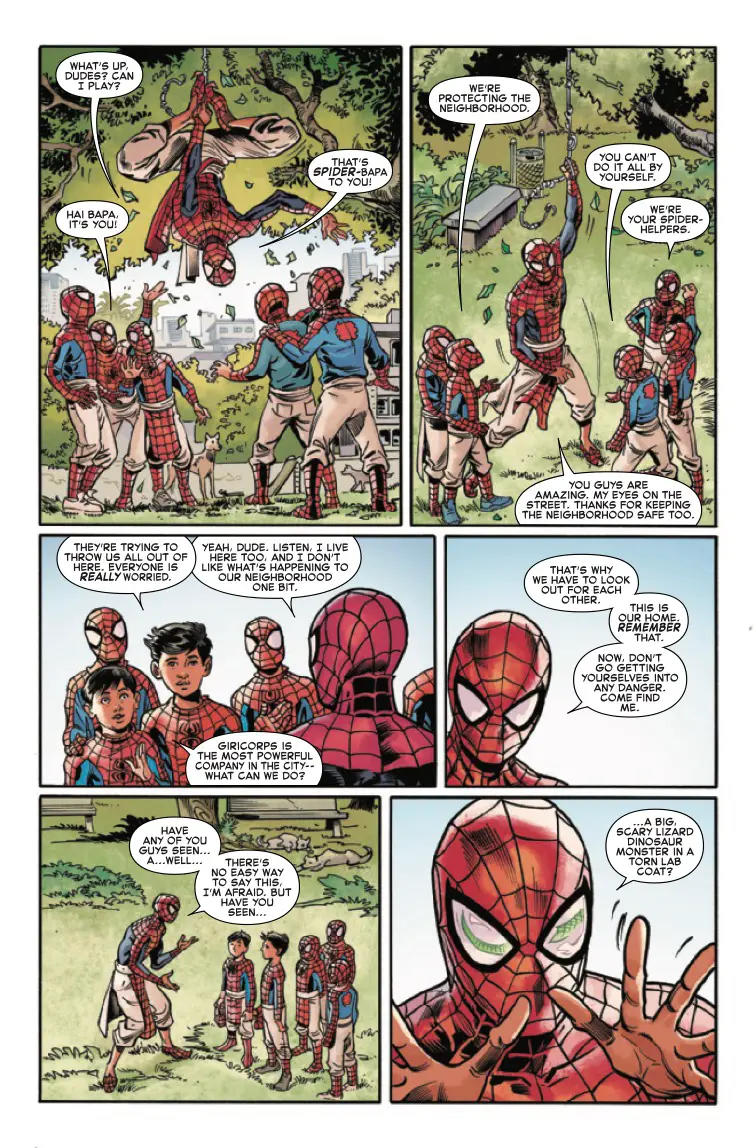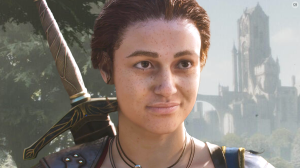Pavitr Prabhakar / Spider-Man: India has become one of this year’s breakout characters, with the recent hit animated movie Spider-Man: Across the Spider-Verse introducing him to a whole new generation. 2023 has also brought the launch of a new Spider-Man: India comic series, the first for Pav since he first made his comic debut in 2004. The new Spider-Man: India miniseries is brought to life by writer Nikesh Shukla and artist Abhishek Malsuni. While Spider-Man: India is Shulka’s comic debut, he enters the medium with a pretty formidable bibliography, including The Good Immigrant, The Boxer, and Brown Baby: A Memoir of Race, Family and Home.
Videos by ComicBook.com
In celebration of the publication of Spider-Man: India #2, ComicBook.com sat with Shukla to talk about his reverential approach to the newest chapter of Pav’s life. We spoke about Spider-Man: India‘s reinventions of iconic villains, Pav’s obsession with food, and what other Marvel characters he would like to take a crack at.

Fan Reaction
ComicBook.com: What has it been like to see the reaction to the series thus far?
Nikesh Shukla: I’m going to be honest, I haven’t checked too much the reaction, because I am a fan too and I’m a reader too. And I know how passionate people are about the Spider-Verse, and also Pav not having had that many stories sort of dedicated to him out there. The first issue came out, and I was still working on on the script for Issue #5. So I kind of wanted to not be swayed by what people might be thinking, especially now that Issue #1 and #2 are out in the world, and Across the Spider-Verse is out in the world.
Also, having been a novelist for a long time, and also a writer who has written a lot about race and immigration, which is quite contentious and it attracts a certain kind of audience. I think I’ve just learnt the hard way that reviews are not for me, therefore they’re for the readers. They’re for readers to gauge what things are. For me as an artist, the best thing I can do is tell the story that I set out to tell, if that makes sense. So I’ve kind of just stayed away from the reaction a little bit.
Spider-Verse
Kind of going off of that, Pav is now a household name for a lot of people, thanks to Spider-Verse. Do you feel like that adds any sort of pressure, now that fans have a much stronger attachment to the character?
Yeah. When I saw the movie — which I loved. I thought the movie was awesome, and that clip of Pav had been circulating for a month or so before the movie came out, and it is a very different take from what I’m trying to do. But the good thing is, I think there’s room for more than one take on the same character. We’ve seen so many different facets of Peter over the 60 plus years that he has been in the comic books. There’ve been so many different takes of Miles, and there’ve been so many different takes of all of our favorite characters. There is so much room for those different interpretations. There’s different facets of those characters. They can be different people in different circumstances. So when I saw the film, I was like, “I love this guy.” I love this guy that they’ve portrayed, and within the context of the movie and within the realm of the movie, he’s the happy-go-lucky Spider-Man. He’s just having loads of fun being Spider-Man, and that’s so cool. I love that he gets to have fun.
When I first set out to flesh out the short pitch that I’d sent Marvel for my miniseries — which was ages and ages ago now — I had to think a lot about what I wanted to do. Because everyone who wants to write comic books, probably wants to write within the Spider-Verse, right? That’s like the golden ticket. He’s one of the most loved characters in one of the most loved universes that we have. I had to think a lot about what I was bringing to the table as a writer. I’ve been a novelist for nearly 15 years. I’ve written for screen, I’ve written for stage, I’ve written 7+ books, and each of those is me. Each of those is my voice. So I had to bring my voice to Spider-Man as well. I couldn’t just pitch to Marvel what I think they want me to do. I had to go, “Well, what do I want to read?” I want to be the first customer of what I’m trying to do, so I had to really think about what I wanted to see. And what I wanted to see was street-level Spidey, because street-level Spidey in Mumbai is interesting to me. You get to have those street-level stories that I love, the ones that are really grounded and gritty, and they’re contemporary, and they’re often reflecting what’s going on in society.
You put it in a city that’s familiar to me, familiar to millions and millions of people, but may not be familiar to the average Spider-Man reader. And you get to see the similarities between New York and Mumbai. You also get to just see the specificity in the universality of the kinds of things that these guys go through. And also, because there hasn’t been much canon and the first miniseries was such a brilliant retelling of the Spider-Man origin, and the film take is wild and fun and funny, I wanted to do something classic. The thing about the representation of South Asian superheroes is that we don’t have that many, and we also don’t have that many doing a classic story with classic beats, with classic villains and all the rest of it. I just wanted it to feel classic and timeless.
Spider-Helpers

The first scene with the Spider-Helpers in Issue #2 tugged on my heartstrings. What was the decision making behind including that scene and having that be part of Pav’s world?
I was a youth worker from 2013 to 2019, and working with young people was what one of the greatest honors and joys of my life, and mentoring young people to tell the stories that they wanted to tell in their voices. That “if you see it, you can be it” kind of vibe. One of the reasons I started writing YA, one of the reasons I started writing middle-grade, was because I wanted to fill up the bookshelves for young people. So reflecting that in this Spider-Man story, it was literally just me going, “How do I show that? How do I show that he’s part of a community? Who is he? Who is he serving? Who is he working for and who is he a hero to?”
If you take the very well-worn “with great power comes great responsibility” line of the original comic, it made me think a lot about Seva, which is selfless community service. [It’s] the stuff that you do to help people in society, in your community, who need help for whatever reason, whether it’s cooking, providing meals for people, or providing services for people, or just making sure that your community is looked after. I thought, “Well, Spider-Man does Seva.” That’s what he’s doing. He’s providing protection for his communities. He’s helping his community where he can, and the people who are going to be the most wide-eyed about the possibility of who he is will be the kids. So that’s why I put those people in there. And also, I have two young daughters, I have nieces and nephews, and I just wanted them to be able to read it and go, “Yeah, this feels like it’s for me as well.”
Misinformation
On the flip side of that, the issue introduces other villains and other things for him to fight, including the community itself kind of turning against Spider-Man. What was the thought process of doing that in the context of this story?
I guess having been on social media for so long now, and written extensively about social media for my second novel, and having written about race and immigration prominently on platforms like Twitter and seeing the reaction… you see how reputations get ruined by Twitter, by people’s reactions to things that you may have said or done that may be taken out of context and all the rest of it. We are going to build on that in Issue #3 in a really interesting way, because I just really want to address this feeling that the voice of the community has been taken over by this nefarious corporation, and people are being influenced by voices that have ulterior motives. Which, ultimately, is what I probably think about social media. We think it’s there to connect us all and democratize our voices, but really, it’s just there to sell us stuff. Just looking at how I used to be verified on Twitter, and now if I want to be verified again, I got to pay for it. Whereas before, it was to protect me from armies of trolls who hated me for whatever reason. And then Instagram, every third or fourth thing in your feed is somebody trying to sell you something. So all of these things are designed to sell stuff to you, and they just got really good at selling you things.
There is a voice at the top of that pyramid, deciding where the influence lies, and that’s really interesting to me. So I really wanted to play with that. So that’s something that we’re going to explore in Issue #3 and in a bit of Issue #4. Issue #3 is kind of an interesting pivot for the storyline. I’m really excited for people to see where it goes.
Food
I’m a huge iced coffee person. What was the inspiration for Pav’s running joke about it in Issue #2? Are you also an iced coffee drinker?
Yeah! Come on, it’s hot. It’s summer. I love iced coffee. When I wrote the first script, and it kind of opened with this joke about how Pav is always hungry and the point at which he gets to eat, it gets taken away from him. That just became this sort of motif through all of the issues. So he never quite gets food, but he’s always trying to use it to barter. Even the dosa he has with Pete and Miles in Issue #1, he doesn’t like it very much. Food is the great democratizer. Sitting down eating a meal with people, you can learn more about each other than if you just duke it out on social media.
So the iced coffee joke, the pastry jokes, they were just his way of looking at the world. “Hey, why can’t we just go and eat some food and talk this out? It’ll be fine.” It is just my attempt to give him a softer side, because he’s in his feels in this miniseries. He really is. I did see somewhere that people were like, “Oh, he seems like classic miserable Pete Parker-style Pav.” I’m like, “Yeah, sometimes people are like that.” Sometimes I’m up, sometimes I’m down, sometimes I’m happy-go-lucky, sometimes I’m really in my feels. And in this arc, he’s in his feels. And that’s okay. Let’s not shame him for his mental health issues. [laughs]
Spider-Man: No More
The Spider-Man: No More moment that we get at the very end of the issue was very awesome to see. How did it feel to put your own stamp on that iconic moment for Pav?
Every now and then, I manage to get one of those classic reference points in, and it makes me very so happy. When I set out to be a writer, I started when I was a shy teenager and I would sit in my room and listen to the Wu-Tang Clan and just write my own Spider-Man stories. I can’t draw, I can’t illustrate, but I would just come up with these arcs. And then I started to tell my own stories, and then I became a novelist and I’ve done all this stuff. At no point did I ever think in my wildest dreams, in all of the things that I wanted to do in my career, it never on the list was write a Spidey comic. Not because I didn’t want to do it, but because I just thought it was completely unattainable and it just wasn’t ever going to be in the cards for me.
And then through the kindness of people on Twitter… One day, I was having a pretty bad time of it and I thought, “I’m going to try and manifest something good.” So I just tweeted one day, “One day I’d like to write a Spider-Man comic.” And the lovely, incredible Jamie McKelvie follows me on Twitter. We follow each other on social media, and he just messaged me and was like, “Are you serious? I can try and make that happen for you. I think that’d be a really cool move for you.” And I was like, “Yeah, sure. Whatever, man.” I still didn’t think it could happen. And then the next thing I knew, he was put me in touch with Nick Lowe, the executive editor of Spider-Man comics at Marvel.
And I was like, “Oh my God, this is f-cking real. I better pitch him something.” And I was just stuck for ages. We traded back and forth a couple of emails, just getting to know each other and setting up a meeting time. And then I was thinking about Pav, because I was wondering whether he’d make an appearance in Across the Spider-Verse. The teaser trailer had just dropped, and there were a couple of Easter eggs that people were wondering about in all of the articles and YouTube breakdowns and all the rest of it. So I thought, “Wouldn’t it be cool to bring him back? Even if I don’t get to do it, it’d be good to just put in Nick’s mind that it is something worth thinking about.” He just got back to me really quickly and was like, “Yeah, we definitely want to do that. We’ve been talking about that ourselves.”
Thinking about what I wanted to do, that’s where I was like, “Okay, I’m going to do street-level stuff, because I really love that. I’m going to have a play with the birth of a kingpin.” Giri is kind of the Kingpin of this verse. I love that classic Lizard storyline, [where] Lizard looks at Spider-Man and sort of sees the weakness of who he is, because he thinks about other people and who he could be. And I thought, “That’s what I want to do. I want to take those classic things and do that.” And then I have my Spider-Man: No More moment at the end of Issue #2.
Maybe subconsciously I had done this, but I hadn’t really sort of thought about it in an obvious way, but the awesome Adam Kubert, who’s done all the [covers], just saw something in the script for #3, which I don’t want to spoil, but then he puts on the cover the social media thing about Spider-Man being a menace. And I was like, “Oh my God! Yes, of course! I’ve done the Daily Bugle thing, of turning Spidey into a menace in a fun way.” So all those things are sort of peppered throughout, and they’re just me going, “I can’t believe they let me do this. This is so cool.” But the reality is, Marvel’s letting me do it. I’ve come to them with a story that I really want to tell and they trust me to write it. That’s the joy of this whole experience, is I’m writing the story that I really wanted to read, and that’s such an honor for me.
What’s Next

You mentioned Issue #3 is a little bit of a departure. What can you tease about what is next for Pav?
Well, he’s Spider-Man no more, and now he has all this free time in his hands. He’s sort of thinking, “Well, how to fill that time?” And so Pav gets a job, and hilarious high jinks ensue.
Champions
You mentioned being such a super fan, and the surrealness of getting to write this character. Are there any other characters, Marvel, DC otherwise, that you would want to take a crack at?
I would love to write Daredevil. I love Daredevil so much. I came to Daredevil a lot later than I did Spidey, I’ve been reading the Spider-Man book since I was sort of 10 or 11. But Daredevil, I kind of came to in my teenage years. I think it was around the classic Frank Miller run, and people were just talking about it in my local comic shop, so I just picked one issue up on a whim and never looked back. I’d love to have a go on a Daredevil thing.
I’d love to do a Pav and Miss Marvel team-up. I think that would be cool. But also the book that I love that I would love to do an arc on is Champions. And I think that a lot of that is to do with being a YA writer, and thinking about middle grade and kids as an audience and stuff. And I just think that team, those adventures, they’re so relevant and contemporary and they’re so funny and they’re so fun and joyful and silly and age-appropriate. I love them so much. I’d love to do Champions.
Spider-Man: India #2 is now available wherever comics are sold.








